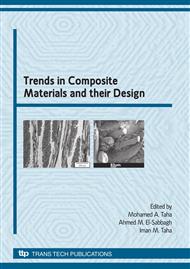[1]
K.P. Menard: Dynamic mechanical analysis: a practical introduction, (CRC Press LLC, 1999).
Google Scholar
[2]
Th. Lampke: Beitrag zur Charakterisierung naturfaserverstärkter Verbundwerkstoffe mit hochpolymerer Matrix, Ph. D Thesis, TU Chemnitz, Germany (2001).
Google Scholar
[3]
K. Hying: Analyse viskoelastischer Eigenschaften von Poly(tetrafluorethylen) im Bereich des βÜbergangs, Ph. D Thesis, RWTH Aachen, Germany (2003).
Google Scholar
[4]
A.G. Odeshi: Beitrag zur Herstellung von Kohlenstofffaserverstärkten KeramikmatrixVerbunden, Ph.D. Thesis, TU Chemnitz, Germany (2001).
Google Scholar
[5]
M. Metten: Veränderung der Verbundfestigkeit von Hart/Weich-Verbunden und die mechanischen Eigenschaften von thermoplastischen Elastomeren durch eine Elektronenbestrahlung, Ph. D Thesis, TU Darmstadt, Germany (2002).
Google Scholar
[6]
H. Mucha: Untersuchung der Porositätsentwicklung von Phenolharzen als polymere- und Kohlenstoffspendermatrices in C-Faserverbundwerkstoffen, Ph. D Thesis, TU Chemnitz, Germany (2007).
Google Scholar
[7]
N.N. Operating Instructions for EPLEXOR, Fa. GABO (2004).
Google Scholar
[8]
B. Wielage, H. Mucha and A. Odeshi: Dynamisch und thermische Analyse von kohlenstofffaserverstärkten Phenolharzverbunden, Tagungsband Verbundwerkstoffe und Werkstoffverbund, edited by K. Schulte und K.U. Kainer (1999), 358 ff.
Google Scholar
[9]
B. Heidenreich: Herstellung von Faserkeramiken nach dem Flüssigsilizierverfahren (LSITechnik), Keramische Verbundwerkstoffe, (2003), 48 ff.
DOI: 10.1002/3527607315.ch3
Google Scholar
[10]
B. Wielage, A.G. Odeshi, H. Mucha, H. Lang and R. Buschbeck: J. Mater. Process. Technol. Vol. 132 (2003) p.313.
Google Scholar
[11]
A.G. Odeshi, H. Mucha and B. Wielage: Manufacture and characterisation of a low-cost carbon-fibre-reinforced C/SiC dual- matrix composite, Carbon Vol. 44 (2006), p. (1994).
DOI: 10.1016/j.carbon.2006.01.025
Google Scholar
[12]
W. Schäfer and W.D. Vogel: Faserverstärkte Keramiken hergestellt durch Polymerinfiltration, Keramische Verbundwerkstoffe, (2003) 76-93.
DOI: 10.1002/3527607315.ch4
Google Scholar
[13]
Z. Ahmad, M.I. Sarwar and J.E. Mark: Dynamic-Mechanical Thermal Analysis of AramidSilica Hybrid Composites Prepared in a Sol-Gel Process, Journal of Applied Polymer Science, 63 (1997) 1345-1352.
DOI: 10.1002/(sici)1097-4628(19970307)63:10<1345::aid-app14>3.0.co;2-3
Google Scholar
[14]
E. Roeder, H. -J. Mayer and R. Liedhegener: Elastizität und mechanische Dämpfung eines unidirektional SiC-kurzfaserverstärkten Alkali-Kalk-Silicatglases, Materialwissenschaft und Werkstofftechnik, 25 (1994) 244-251.
DOI: 10.1002/mawe.19940250609
Google Scholar
[15]
N.P. Bansal: Handbook of ceramic composites. Boston: Kluwer, (2005).
Google Scholar
[16]
H. Mucha, Y. -E. Kim and B. Wielage: Approaches to reveal porosity in Phenolic Resin derived CFRP and C/C Composites, 16th ICCM, Kyoto, Japan, (2007).
Google Scholar
[17]
H. Salmang and H. Scholze: Keramik, Springer Verlang, (2007).
Google Scholar
[18]
K. Hultzsch: Chemie der Phenolharze, Springer Verlag, Berlin, Germany, (1950).
Google Scholar
[19]
H. Mucha, B. Wielage, R. Buschbeck and H. Lang: Untersuchung von PhenolformaldehydHarzen als Matrixmaterial für C/C-Verbunde, Verbundwerkstoffe und Werkstoffverbunde (2005) 217-222.
Google Scholar
[20]
J. Schulte-Fischedick, S. Seiz, N. Lützenburger, A. Wanner and H. Voggenreiter: The crack development on the micro- and mesoscopic scale during the pyrolysis of carbon-fibrereinforced plastics to carbon/carbon composites, Composites Part A, 38 (2007).
DOI: 10.1016/j.compositesa.2007.06.013
Google Scholar


